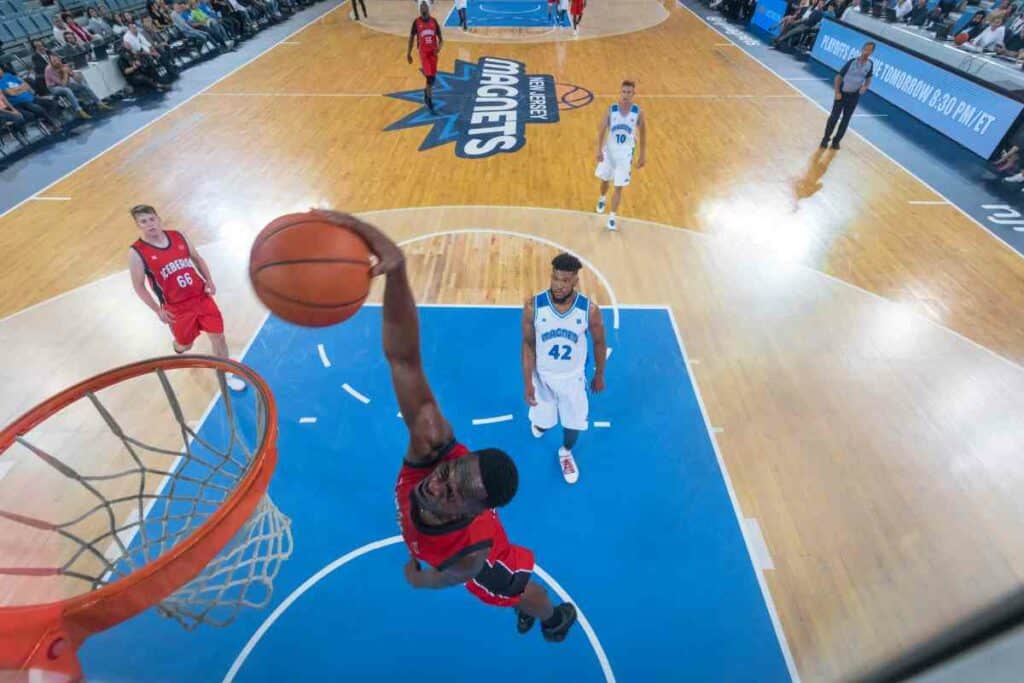How Many Minutes Are in a Basketball Game?
Whether you’re a seasoned fan or new to the sport, understanding the timing of basketball games is crucial to fully enjoy the action. From the fast-paced professional leagues to high school courts, the duration of a basketball game varies, offering a unique experience at each level.

Related Post! How Long Is A Period In Basketball?
How Many Minutes Are In A Basketball Game?
In the NBA, games consist of four 12-minute quarters, totaling 48 minutes. College games typically have two 20-minute halves, amounting to 40 minutes. High school games often feature four 8-minute quarters, resulting in 32 minutes of play.
While the scheduled times are set, the actual length of a basketball game often extends beyond these limits. Why? The game clock stops for various reasons, including timeouts, fouls, and violations. This means the real-time duration of a game can be significantly longer, adding to the suspense and excitement.
Key Takeaways for Basketball Fans
- Regulation Times Vary: Games can last 32, 40, or 48 minutes, depending on the level of play.
- Extended Play: Timeouts, fouls, and other stoppages often prolong the actual game duration.
- Overtime Dynamics: Tied games lead to additional 5-minute play intervals in professional and international games, and slightly shorter in college and high school games.
Professional Basketball
In the world of professional basketball, particularly the NBA, games are a thrilling 48-minute journey, divided into four 12-minute quarters.
But here’s the catch: if the game ends in a tie, get ready for more excitement with 5-minute overtime periods. This structure not only showcases the players’ incredible skills but also keeps you on the edge of your seat, especially during those nail-biting overtime moments.
Related Post! Does College Basketball Have Quarters Or Halves?
College and High School Basketball: A Closer Look

Turning to college basketball, the NCAA opts for a different approach with two 20-minute halves, totaling 40 minutes of game time.
High school games, on the other hand, are slightly shorter. They feature four 8-minute quarters, culminating in 32 minutes of play.
Overtime in these games adds a twist, with college games having 4-minute overtimes and high school typically 3 minutes. These variations ensure a dynamic and engaging experience for players and fans alike.
Related Post! How Many Quarters Are In A Basketball Game?
International Basketball: FIBA’s Unique Timing
On the international stage, FIBA games closely resemble the NBA format but with a slight twist: each quarter is 10 minutes, leading to a 40-minute game.
Like the NBA, FIBA also includes 5-minute overtimes. This setup balances the intensity of the game with the endurance of the players, ensuring a captivating experience for global audiences.
Clock Management
Grasping the concept of clock management is key to truly understanding the rhythm and strategy of a basketball game. It’s not just about the ticking seconds but how they’re utilized through shot clock regulation, strategic timeouts, halftime intervals, and various stoppage time factors.
Let’s dive into these elements that significantly influence the game’s flow and duration.
Shot Clock Dynamics
The shot clock is a pivotal aspect of basketball. It gives your team a 24-second window to attempt a shot that must hit the rim. Failing to do so results in a shot clock violation, handing the ball over to the opposition.
Here’s an interesting twist: if your team’s shot hits the rim and you regain possession, the shot clock resets, but only to 14 seconds. This rule keeps the game fast-paced and challenging.
Strategic Use of Timeouts and Halftime
Timeouts are crucial for strategy and rest. In the NBA, each game includes seven 75-second timeouts and two 20-second timeouts. These breaks are not just for rest; they’re strategic tools for coaches to adjust tactics or motivate players.
The halftime interval, a 15-minute break after the second quarter, is another critical period for in-depth team discussions and strategizing for the half ahead. Note that timeouts, especially in televised games, often align with commercial breaks, which can extend the real-time length of the game.
Understanding Stoppage Time Factors

Several scenarios can cause stoppages in a basketball game. When the ball goes out of bounds, the game pauses until it’s inbounded. During free throws, the game clock stops, resuming once play restarts.
Substitutions, TV timeouts, and in the final minute of the game, the clock stopping after a made basket are other common stoppage reasons. These moments are crucial in the game’s flow and can be game-changers in strategy and outcome, especially in tightly contested matches.
Extended Play: Navigating Overtime
In professional basketball, a tied score at the end of regulation leads to an exhilarating phase: overtime.
Overtime Rules in the NBA and WNBA
Both the NBA and WNBA follow the same overtime protocol. If the game is tied at the end of the fourth quarter, it moves into a 5-minute overtime period. And if the score is still tied? Additional overtimes are played until a winner emerges.
- NBA and WNBA Overtime: Each period lasts 5 minutes.
- Trigger for Overtime: A tied score at the end of regulation.
- Multiple Overtimes: Possible if the score ties again at the end of an overtime period.
A Glimpse into Historic Overtime
One unforgettable moment in NBA history is the six-overtime game between the Rochester Royals and the Indianapolis Olympians on January 6, 1951. This epic showdown holds the record for the most overtimes in an NBA game, showcasing the intensity and unpredictability of basketball.
- Historic Overtime Game: Rochester Royals vs. Indianapolis Olympians
- Date: January 6, 1951
- Overtime Record: Six periods
In basketball, understanding infractions and penalties is crucial for appreciating how they influence the game’s flow and outcome. From fouls leading to free throws to violations affecting the game clock, these elements play a significant role in the dynamics of a basketball match.
Fouls and Free Throws: Impact on the Game
A foul in basketball is a violation of the rules concerning illegal personal contact with an opponent or unsportsmanlike behavior. Let’s break it down:
- Shooting Fouls: Occur when a player is fouled during a shot attempt. This leads to free throws, where the number of shots awarded depends on the situation:
- If the shot is made despite the foul, one free throw is awarded.
- If the shot attempt fails, the player receives two free throws, or three if they were attempting a three-pointer.
Violations and the Game Clock
Violations, such as travelling or a shot clock violation, differ from fouls. They impact the game by stopping the clock when the whistle blows. After a violation:
- The game clock is paused until play resumes.
- Often, there’s a change of possession.
- Unlike fouls, violations do not lead to free throws but can significantly shift the game’s momentum.

Special Considerations in Game Duration
When considering basketball game lengths, it’s important to recognize variations, especially in youth basketball and scenarios involving the mercy rule.
Youth and Recreational Basketball Timing
In youth basketball, game lengths often differ from the professional 48-minute standard. Games are typically divided into shorter periods, with quarters lasting about 6 to 8 minutes. Running clocks, where the clock doesn’t stop for every play, are common, speeding up the game and reducing total duration. For instance:
- Quarters: 4 x 8 minutes (32 minutes total)
- Halftime: 10 minutes
These durations can vary based on the league, age group, or specific tournament rules.
The Mercy Rule and Game Length Adjustments
The mercy rule is applied to prevent games from continuing unnecessarily when there’s a significant score difference. For example, if a team leads by 20 points, a running clock may be used for the remainder of the game. This rule helps manage game duration effectively and maintain sportsmanship. Under the mercy rule, the game clock continues to run through usual stoppages, including:
- Fouls
- Baskets scored
- Ball out of bounds
By understanding these aspects of infractions, penalties, and special considerations in game timing, you gain deeper insight into the strategic and practical elements that shape the duration and flow of a basketball game. Whether it’s a youth game, a recreational league match, or a situation where the mercy rule comes into play, these factors are essential in shaping the basketball experience.
Frequently Asked Questions
Understanding the various game durations in basketball is crucial as they vary by league and level of play.
What is the duration of a quarter in an NBA basketball game?
In an NBA game, each quarter lasts 12 minutes, with the game consisting of 4 quarters in total.
How long does a typical high school basketball game last?
High school basketball games generally have 8-minute quarters, amounting to a total game time of 32 minutes.
Can you explain the basketball time regulations regarding game duration?
Basketball games are divided into quarters or halves, with a set time per section. The total duration often includes the halftime break and any potential overtimes, with each overtime lasting 5 minutes in many leagues.
What is the length of a game under FIBA rules?
FIBA rules stipulate that the game comprises 4 quarters, each 10 minutes long, leading to a total of 40 minutes of playing time.
How many minutes does a WNBA basketball game consist of?
WNBA basketball games have 10-minute quarters, summing up to 40 minutes of playtime.
What is the average length of a college basketball broadcast on television?
College basketball broadcasts typically extend for around 2 hours, though the actual playing time consists of two 20-minute halves totaling 40 minutes.
